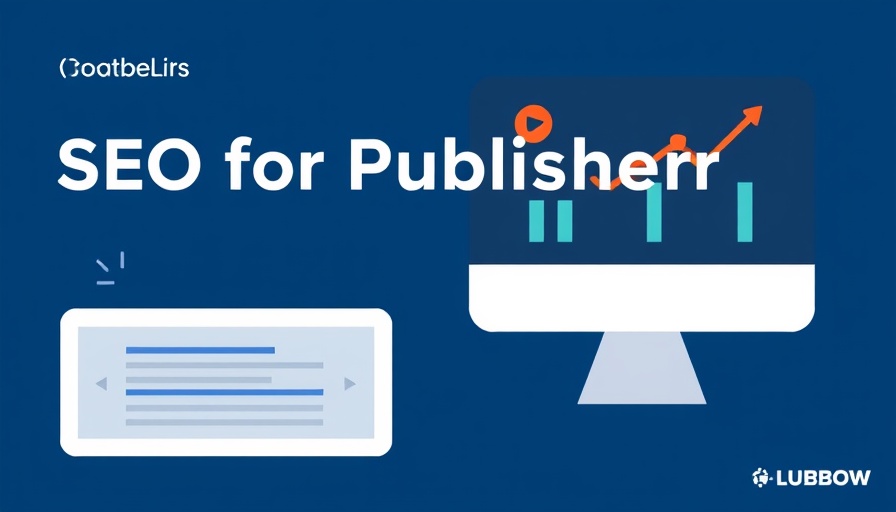
Understanding SEO for Publishers: The Modern Challenge
In the digital landscape, search engine optimization (SEO) has become an essential avenue for publishers seeking to enhance their online visibility. For small and medium-sized businesses, leveraging SEO can dramatically boost traffic and increase revenue through ad placements and more significant reader engagement. However, with the rise of generative AI tools and evolving search engine dynamics, our approach to SEO must adapt.
The Ad Revenue Equation: Maximizing Results Through SEO
To illustrate the impact of effective SEO, consider a hypothetical publisher earning about $5,000 per day from ad impressions. By implementing a refined SEO strategy, this publisher could attract more traffic to their website, potentially increasing ad views and consequently revenue. In a market where ad dollars are tightly contested, the dividends of a well-executed SEO strategy can be substantial.
Challenges Faced by Publishers in Today's Digital Age
Despite its potential, publishers encounter several SEO challenges that can hinder their growth. Here are five considerable hurdles:
Challenge 1: AI Tools Reducing Site Traffic
One of the primary difficulties is how AI tools, such as ChatGPT and Google's AI modes, are redefining organic traffic. When users can receive direct answers from these platforms, the necessity to click through to original sources diminishes. This phenomenon, dubbed 'The Great Decoupling', shows that while publishers may garner numerous impressions, the actual clicks might dwindle. Establishing trustworthiness and focusing on branded searches or original content is critical to overcoming this challenge.
Challenge 2: Crawlers Struggle with Frequent Updates
Moreover, web crawlers can struggle to keep pace with frequently updated content across publisher sites. A densely packed schedule of new articles may delay the indexing of these pieces on search engines. Maintaining a clear site structure and directing crawlers to vital pages can alleviate this problem.
Challenge 3: Content Quality Over Quantity
In a world flooded with information, the quality of content published takes precedence over quantity. This is paramount for engagement and improving search rankings. Thus, focusing on quality content—backed by research and data—can foster trust and enhance user retention.
Challenge 4: SEO Misconceptions
Many publishers are held back by misconceptions surrounding SEO. For example, some believe optimizing for keywords alone guarantees success. Instead, a holistic SEO strategy involving backlinks, site performance, and mobile usability is vital. This understanding prepares publishers to navigate the landscape more effectively.
Challenge 5: Adapting to Algorithm Changes
Lastly, as search engine algorithms shift, publishers must adapt their strategies continually. Staying informed about updates—like Google's emphasis on E-A-T (Expertise, Authoritativeness, and Trustworthiness)—will aid in aligning content strategies with search engine priorities.
Practical Steps for Effective SEO Implementation
For publishers grappling with these challenges, several actionable steps can be taken:
1. Focus on Providing Value
Creating original, high-quality content that meets the needs of your target audience is essential. The goal is to engage readers so deeply that they view your publication as a trusted source.
2. Optimize for Mobile
Given that a significant portion of traffic now comes from mobile devices, ensuring your website is optimized for mobile viewing is crucial for maintaining search rankings and enhancing user experience.
3. Improve Technical SEO
Enhancing technical aspects of your website such as load times, site speed, and mobile responsiveness can dramatically improve both user experience and search engine rankings.
Looking Forward: Predictions and Trends in SEO
As we approach the future, predicting how SEO will evolve is vital for strategic planning. With the ever-increasing prevalence of AI in content curation and recommendation, publishers might need to rethink their approaches to content distribution and visibility. Understanding user behavior, adapting to technological advancements, and maintaining a focus on genuine engagement will be essential.
Call to Action: Embrace SEO Today!
The landscape of digital publishing is shifting rapidly, and those who are willing to adapt their SEO strategies accordingly will likely find themselves ahead of the competition. Adapt now and start enhancing your content visibility to unlock greater possibilities for traffic and revenue growth!
 Add Row
Add Row  Add
Add 



Write A Comment